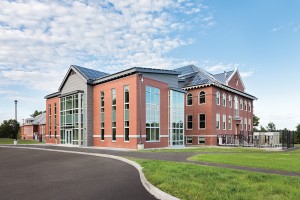Hinckley, ME According to Harriman, an architecture and engineering firm with offices in Portland and Auburn, ME, Manchester, N.H., and Boston, the Maine chapter of the American Institute of Architects (AIA Maine) Committee on the Environment (COTE) has recognized the firm with a special citation for historic adaption for its work on the Good Will-Hinckley Moody School renovation and addition. The AIA Maine COTE Awards program recognizes exemplary and innovative built projects that establish a standard of over-all design excellence that creatively integrates sustainable design strategies, demonstrating their benefits while educating and inspiring the profession and the public.
Starting in 2012, Harriman was contracted to assess and design renovations for the original 16,150 s/f, 12-classroom school, and a 7,200 s/f addition to create five new classrooms to house the MeANS Charter School. The design approach is respectful of the historic building, retaining much of the original character defining features, while developing highly energy efficient alterations and classroom addition.
The building is designed to an energy usage level 30% less than a conventional building. This is achieved through the use of energy efficient mechanical and lighting systems. The building’s exterior incorporates insulation values in excess of code requirements. In addition, 267 photovoltaic panels were installed on the building and are expected to deliver 90,000 kWh of power. The Moody School will use 77,000 kWh annually, leaving a “net positive” of 13,000 kWh of clean, renewable power. This will offset the energy needs of adjacent greenhouses and other facilities on campus.
In addition to Harriman, project team members include Landry/French Construction Co.; Lowell Specifications; Conestco; GO Logic; Building Envelope Specialists and Nova Consulting Group.
The jurors’ commented: “We found this project to be a very solid example of a path to elevating even a Historic Registry building to 21st standard of comfort and performance. This was a good size, and complex project, where the existing building was retrofit and the addition was well above code to elevate the final performance results. The inclusion of a significant PV array achieves a predicted energy neutral or better result. The high performance addition is well attuned to the historic architecture, while clearly presenting a contemporary rendering or the traditional material palette. The process clearly demonstrated an integrated approach that responded to energy modeling to capture design and technical opportunities well.”
For more than a century, Harriman has designed the buildings that represent what is important and special about communities throughout New England. An architecture and engineering firm founded in 1870, we work with clients in the education, healthcare, government, corporate, and retail sectors transforming vision to reality. Harriman pursues creative partnerships to design relevant and innovative solutions to human needs. Our work is based on the belief that design is a collaborative human endeavor centered on knowledge, ingenuity, and beauty. Through practicing the art of architecture and the science of engineering, we create environments that honor context, embrace wisdom, and enhance well-being.









